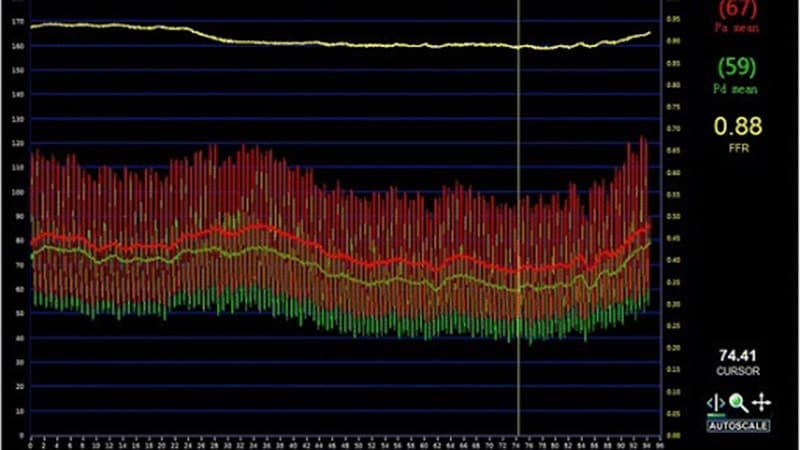Cost-Effectiveness of FFR-Guided PCI in AMI Patients
Core Concepts
FFR-guided PCI is more cost-effective and improves quality of life compared to angiography-guided PCI in AMI patients with multivessel disease.
Abstract
TOPLINE:
FFR-guided PCI saved costs and improved quality of life in AMI patients with multivessel disease.
METHODOLOGY:
Analysis of FRAME-AMI trial compared cost-effectiveness of FFR-guided PCI with angiography-guided PCI.
FFR-guided PCI showed superiority in primary endpoints.
562 patients with AMI and multivessel disease were included.
TAKEAWAY:
FFR-guided PCI increased quality-adjusted life years and reduced costs compared to angiography-guided PCI.
Incremental cost-effectiveness ratio favored FFR-guided PCI.
IN PRACTICE:
Authors recommend considering FFR-guided PCI for non-IRA stenoses in AMI patients.
SOURCE:
Study published in JAMA Network Open.
LIMITATIONS:
Outcomes depended on limited earlier studies.
Trial ended early due to COVID-19.
Cost-effectiveness may have been affected by patients not undergoing FFR interrogation.
DISCLOSURES:
Trial funded by Medtronic, Biotronik, Chong Kun Dang Pharmaceutical, and JW Pharmaceutical.
Fractional Flow Reserve-Guided PCI Cost-Effective
Stats
FFR-guided PCI increased quality-adjusted life years by 0.06 compared with angiography-guided PCI.
Total cumulative cost per patient in FFR-guided PCI group was estimated to be $1208 less than in angiography-guided PCI group.
Incremental cost-effectiveness ratio was −$19,484 and incremental net monetary benefit was $3378 with FFR-guided PCI.
Quotes
"Fractional flow reserve-guided PCI should be considered in determining the treatment strategy for non-IRA stenoses in these patients."
"These cost-effectiveness data are an important addition to the mixed body of evidence in this domain and may tip the scales toward adoption of an FFR-based strategy to achieve complete revascularization and combat rising costs in AMI."
Key Insights Distilled From
by Shrabasti Bh... at www.medscape.com 02-26-2024
https://www.medscape.com/viewarticle/fractional-flow-reserve-guided-pci-cost-effective-2024a10003pp
Deeper Inquiries
How can the findings of this study impact the current treatment guidelines for AMI patients
The findings of this study have the potential to significantly impact the current treatment guidelines for AMI patients. By demonstrating that Fractional Flow Reserve (FFR)-guided percutaneous coronary intervention (PCI) for non-infarct-related arteries (IRAs) in patients with acute myocardial infarction (AMI) and multivessel disease is not only cost-effective but also improves quality-adjusted life years, the study provides strong evidence in favor of adopting FFR-guided PCI as a standard practice. These results suggest that incorporating FFR guidance in determining the treatment strategy for non-IRA stenoses can lead to better outcomes and cost savings, ultimately influencing the guidelines to recommend FFR-guided PCI over angiography-guided PCI in these patients.
What potential biases or limitations could arise from the trial ending early due to the COVID-19 pandemic
The trial ending early due to the COVID-19 pandemic introduces potential biases and limitations that need to be considered when interpreting the results. One major limitation is the premature termination of the study, which may have impacted the completeness of the data collection and follow-up. This could lead to a potential underestimation or overestimation of the true effects of FFR-guided PCI compared to angiography-guided PCI. Additionally, the early termination may have introduced selection bias if certain types of patients were more likely to drop out or be lost to follow-up due to the pandemic, affecting the generalizability of the findings. Furthermore, the COVID-19 pandemic itself could have influenced healthcare utilization patterns, resource availability, and patient outcomes, potentially confounding the results of the study.
How can the cost-effectiveness of FFR-guided PCI be further optimized to benefit a larger population of patients
To further optimize the cost-effectiveness of FFR-guided PCI and benefit a larger population of patients, several strategies can be considered. Firstly, increasing the awareness and training of healthcare providers in using FFR technology effectively can help ensure appropriate patient selection and accurate interpretation of FFR measurements, leading to more targeted and cost-effective interventions. Secondly, incorporating FFR guidance into the decision-making process earlier in the treatment pathway for AMI patients can help identify non-IRA lesions that would benefit most from PCI, thus avoiding unnecessary procedures and reducing costs. Additionally, ongoing research and technological advancements in FFR technology can help streamline the procedure, make it more accessible, and potentially lower the associated costs, making FFR-guided PCI a more attractive option for a larger population of patients with AMI and multivessel disease.
0
More on Healthcare
